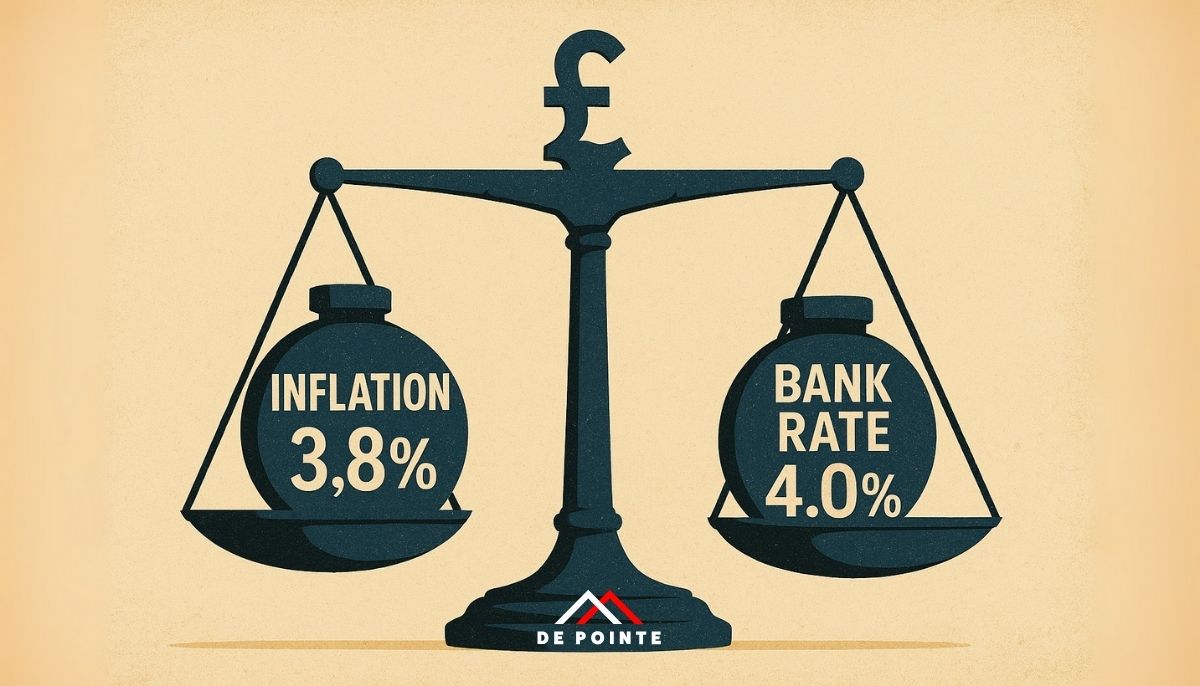Article

The latest UK inflation rates have once again surprised markets. After a steady decline for much of 2024, July 2025 saw inflation climb back up to 3.8% year-on-year, its highest level in over a year. While not at the crisis peaks seen in 2022–23, this uptick underscores how persistent inflationary pressures remain in the British economy.
At the same time, the Bank of England’s Bank Rate currently sits at 4.0%, following a 0.25% cut earlier this month. That leaves a razor-thin margin of just 0.2 percentage points between the official rate and headline inflation. For investors, this narrow gap raises essential questions about where to allocate capital, how to preserve real value, and what to expect from markets in the months ahead.
The Latest UK Inflation Rates
According to the Office for National Statistics, inflation measured by the Consumer Prices Index (CPI) rose to 3.8% in July, up from 3.6% in June. Other measures confirm the persistence of price pressures:
- CPIH (which includes housing costs): 4.2%
- RPI (Retail Prices Index): 4.8%
- Food price inflation: 4.9%, driven by staples such as eggs, butter, and chocolate
This resurgence in inflation comes at a time when many households are already under pressure from elevated borrowing costs, high utility bills, and sluggish wage growth. It also complicates the task for the Bank of England, which is trying to balance price stability with supporting economic growth.
The Bank of England’s Delicate Balancing Act
The Bank of England rate at 4.0% is now only marginally above headline inflation. This slim differential means that real interest rates, the return after accounting for inflation, are barely positive. For savers and investors, that matters enormously.
If inflation were to accelerate further, the Bank would face renewed pressure to tighten again, even after signalling the start of an easing cycle. On the other hand, analysts such as Goldman Sachs have forecast that the Bank could cut rates more aggressively than markets expect, possibly to 3% by early 2026, if growth falters and inflation proves more manageable.
This policy uncertainty adds volatility to both fixed-income and equity markets, creating challenges, but also opportunities, for UK investors.
What the Narrow Gap Means for Investors
1. Cash and Bonds Offer Minimal Real Returns
With the Bank Rate only 0.2% above inflation, cash deposits and short-term government bonds barely preserve purchasing power. Savers may feel like they are finally getting “real” returns after years of negative real yields, but in practice, gains are wafer-thin. Unless inflation falls more quickly than expected, traditional fixed-income remains under pressure.
2. Equities Could Regain Momentum
Equities often benefit when central banks shift towards lower rates. If the Bank of England continues to ease into 2026, growth-oriented and rate-sensitive sectors such as real estate, consumer discretionary, and technology could see renewed interest. However, persistent inflation in consumer staples may weigh on household spending, limiting upside in retail and hospitality sectors.
3. Bond Market Volatility
Investors in gilts and corporate bonds should prepare for volatility. Sticky inflation means yields may stay higher for longer, while potential rate cuts could spark sudden rallies. Inflation-linked bonds (index-linked gilts) may provide a valuable hedge, especially if food and housing costs remain elevated.
4. The Case for Real and Alternative Assets
Periods of high inflation and narrow real yields often strengthen the case for real assets. Commodities, real estate, and tangible alternative investments such as art or gold can provide a hedge against inflation while diversifying portfolios. De Pointe Research has long highlighted the value of allocating 10–20% of portfolios to alternative asset classes, precisely because they are less correlated to traditional markets and can preserve capital in times of macroeconomic stress.
5. Household Squeeze and Consumer Risk
Food inflation at 4.9% is particularly damaging for households. Rising costs in everyday essentials mean less disposable income for discretionary purchases, a factor that will weigh on certain consumer-facing stocks. For investors, this reinforces the need to be selective and focus on companies with strong pricing power and resilient demand.
Looking Ahead: Key Risks and Opportunities
The future path of UK inflation rates will dictate much of the investment landscape for the rest of 2025. Some of the key risks and opportunities include:
- Persistent price pressures: If services and food inflation remain sticky, real yields could turn negative again, punishing savers.
- Potential rate cuts: If the economy slows, investors may see a more aggressive easing cycle, supporting equities and property markets.
- Global divergence: The gap between UK inflation and that of the Eurozone or the US could affect capital flows and currency strength, impacting exporters and international investors.
- Alternative allocation: In uncertain environments, tangible assets such as gold, fine art, or real estate provide both diversification and potential long-term capital appreciation.
Conclusion: Navigating a Narrow Margin
The July 2025 data has confirmed what many investors suspected: UK inflation rates remain stubbornly high, and the Bank of England’s current rate policy leaves little margin of comfort. With the Bank Rate only slightly above inflation, cash and bonds offer minimal protection against erosion of value.
For investors, the path forward is straightforward but requires careful balance:
- Stay diversified across asset classes
- Tilt towards inflation-resistant sectors and tangible assets
- Monitor Bank of England signals closely
- Prepare for volatility in both bond and equity markets
In this environment, strategies that combine traditional income-generating assets with tangible alternatives are best placed to preserve capital and capture upside. The coming months will test the resilience of both policy and portfolios, but well-positioned investors can still find opportunities even in a high-inflation, low-real-yield world.






